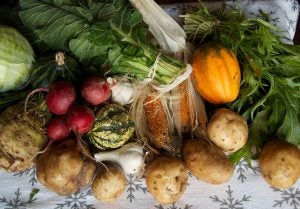In many farms across the nation, the statistics, the market, and the cost of farming has been heavily impacted by the agriculture literacy of the consumers we cater to. Agriculture literacy is defined as “possessing knowledge and understanding of the food and fiber system.”
Throughout the years, there have been growing disconnects and misinformation cycle through various media that make sharing the true narrative of U.S. agriculture difficult to defend. Thus, agriculture literacy programs have been widely implemented in order to help tell agriculture’s story, and they have garnered huge successes among agriculturalists.
Even though agriculture’s poster child to most Americans isn’t a person of color, the history of agriculture literacy programs, a necessary tool for to keep agriculture alive today, was largely trailblazed by people of color.
Black horticulturist Dr. Booker T. Whatley was the father of Community Supported Agriculture (CSA) and the U-pick model, two systems that assisted U.S. farmers to rethink their community engagement practices.
CSA (or what Dr. Whatley originally called “Clientele Membership Clubs) is a program where farms sell shares of their produce to communities looking for seasonally fresh produce.” U-Pick days, where consumers travel to a farm with this program in place and harvest the produce they would like to purchase, were actually built out of necessity for many Black farmers back when it was founded in the late 1960s.
Dr. Whatley was an agriculture professor at Tuskegee University in Alabama, where he mentored Black farmers. Their biggest issue, at the time, was keeping Black farmers’ operations financially afloat. Many Black farmers knew that they wouldn’t be able to attain loans due to heavy government discrimination at the time. Many attempted but failed to acquire one.
So, with the help of Dr. Whatley, Black farmers started implementing CSA and U-pick models to attain financial support from the community through guaranteed monthly income.
Today, Community Supported Agriculture boxes and U-pick days have created bridges between consumer and farmer, allowing for consumers to be a part of the food production process and making how their food is grown relevant to the consumer. Today, data show that CSAs make the average farmer about $1,280 per month. U-pick opportunities often can generate anywhere from $20,000 to $100,000 a month when managed properly.
These numbers may not always seem extremely lucrative; however, the goal of these programs is much more than profit.
Sources from the Michigan State University Ag Extension share that not only do U-pick farms provide a bit of revenue for a farmer and cheaper options for consumers than markets and grocery stores, they also provide a “knowledge of source.”
“There is security knowing that the fresh produce that you and your family are (picking and) eating was grown by a local farmer,” MSU says.
They record that the less distance that a consumer is from their food source, the less chance of contamination because we know exactly what farm the produce was picked at and who picked it (ourselves). I would expect that the author of this MSU document wasn’t just referring to the contamination of the food product, but also the mind of the consumer.
Consumers who go to U-pick days — those who may never have stepped foot on a farm or even seen a farm or farmer face to face — will connect a positive experience they had with agriculture to what they experienced at a U-pick day. And the more times consumers choose to attend these days, the more positive connotations and ideas are reinforced; knowledge of what they are doing and how they are doing it enhance, creating either large or subtle investments within a consumer about agriculture.
CSA’s strategy is to get consumers more literate in agriculture is through their community-based infrastructure. Farmers and community members become partners in making choices of what produce makes it to the consumers dinner tables and consumers get to directly converse with the farmer about their questions and concerns rather than cite their sources from a resource far removed from the field. In turn, the producer is more aware about consumer choices and is able to adapt to the growing desires of their consumer partners — leading producers to become more literate about their consumer.

Dr. Whatley managed to get two very important outcomes out of his work-supporting Black farmers and trailblazing agriculture literacy.
These are two outcomes that we all should be challenged by. Not only is it our encouragement as agriculturalists to advocate for ourselves to our communities in non-traditional and more engaging ways, but it is also our challenge to support our local farmers of color.
As written in my previous column on the Emergency Relief for Farmers of Color Act, the history of discrimination and the policies/practices of the 1910 United States is still alive and well in the lives of farmers of color today. And as we have discovered, CSA and U-pick models have been helpful to farmers in the past to aid in consistent income, but for today’s farmer, they aren’t necessarily going to pay the bills if we take into account inflation and years of generational debt.
As producers, farmers, agriculturalists, we can step up for our fellow farmers — because we are all on the same team, growing food for the world and offer our support and partnership to one another as our world continues to challenge our collective agriculture story. The more united we are, the easier we can share the true story of agriculture.
Bre Holbert is a past National FFA President and studies agriculture science and education at California State-Chico. “Two ears to listen is better than one mouth to speak. Two ears allow us to affirm more people, rather than letting our mouth loose to damage people’s story by speaking on behalf of others.”



